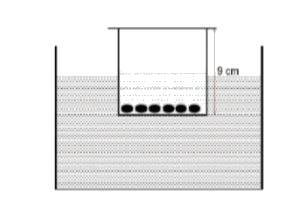Two particles of identical mass are moving in circular orbits under a potential given by V(r)=Kr−n, where K is a constant. If the radii of their orbits are r1,r2 and their speeds are v1,v2, respectively, then
v21rn1=v22rn2
v21r−n1=v22r−22
v21r1=v22r2
v21r2−n1=v22r2−n2
The correct Answer is:A
Step by step video, text & image solution for Two particles of identical mass are moving in circular orbits under a potential given by V(r) = Kr^(-n), where K is a constant. If the radii of their orbits are r_(1), r_(2) and their speeds are v_(1), v_(2), respectively, then by Physics experts to help you in doubts & scoring excellent marks in Class 12 exams.
Updated on:21/07/2023Topper's Solved these Questions
Similar Questions
A wide bottom cylindrical massless plastic container of height 9 cm has 40 identical coins inside it and is floating on water with 3 cm inside the water. If we start putting more of such coins on its lid. It is observed that after N coins are put, its equilibrium changes from stable to unstable. Equilibrium in floating is stable if the geometric center of the submerged portion is above the center of mass of the object) The value of N is closed to

View SolutionTwo satellites of masses of m1 and m2(m1>m2) are revolving round the earth in circular orbits of radius r1 and r2(r1>r2) respectively. Which of the following statements is true regarding their speeds v1 and v2?
View SolutionA plenet moving along an elliptical orbit is closest to the sun at a distance r1 and farthest away at a distance of r2. If v1 and v2 are the linear velocities at these points respectively, then the ratio v1v2 is
View SolutionTwo satellite are revolving around the earth with velocities v1 and v2 and in radii r1 and r2(r1>r2) respectively. Then
View SolutionTwo particles A and B, move with constant velocities →v1 and →v2. At the initial moment their position vectors are →r1 and →r2 respectively. The condition for particle A and B for their collision is
View Solutionद्रव्यमान m की एक गेंद समान अभिकेन्द्री त्वरण अंतर्गत त्रिज्या r1 व r2(r1>r2) के वृत्तीय मार्गो में क्रमशः रैखिक चाल v1 व v2 से गति करती है v1 व v2 में से कौन अधिक होगी ?
View SolutionA planet moving along an elliptical orbit is closest to the Sun at distance r_(1) and farthest away at a distance of r_(2) . If v_(1) and v_(2) are linear speeds at these points respectively. Then the ratio (v_1)/(v_2) is
View Solutionm1 तथा m2 द्रव्यमान (m1>m2) के दो उपग्रह पृथ्वी के चारों ओर क्रमशः r2 तथा r2(r1>r2) त्रिज्याओं की वृत्तीय कक्षाओं में घूम रहे हैं । उनकी चाल v1 तथा v2 के विषय में कौन - सा कथन सत्य है -
View SolutionTwo satellites of masses m_(1) and m_(2)(m_(1) gt m_(2)) are revolving around the earth in circular orbits of radius r_(1) and r_(2)(r_(1) gt r_(2)) respectively, which of the following is true regarding their speeds V_(1) and V_(2) ?
View SolutionA planet moving along an elliptical orbit is closest to the Sun at distance r1 and farthest away at a distance of r2. If v1 and v2 are linear speeds at these points respectively. Then the ratio v1v2 is
View SolutionTwo satellites of masses m1andm2(m1>m2) are moving around the earth in orbits of radii r1andr2(r1>r2). Which one of the following statements about their velocities is correct?
View SolutionTwo satellites of masses m_(1) and m_(2) (m_(1) gt m_(2)) are revolving the earth in circular orbits of radius r_(1) and r_(2)(r_(1) gt r_(2)) respectively. Which of the following statement is true regarding their velocities v_(1) and v_(2) .
View SolutionTwo satellites of masses m1 and m2(m1>m2) are revolving the earth in circular orbits of radius r1 and r2(r1>r2) respectively. Which of the following statement is true regarding their velocities v1 and v2.
View SolutionTwo particles A and B, move with constant velocities →v1 and →v2. At the initial moment their position vectors are →r1 and →r2 respectively. The condition for particle A and B for their collision is
View SolutionA plenet moving along an elliptical orbit is closest to the sun at a distance r1 and farthest away at a distance of r2. If v1 and v2 are the linear velocities at these points respectively, then the ratio v1v2 is
View Solution
